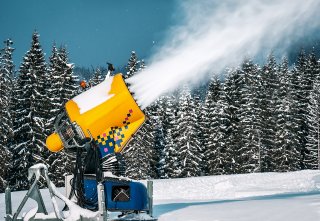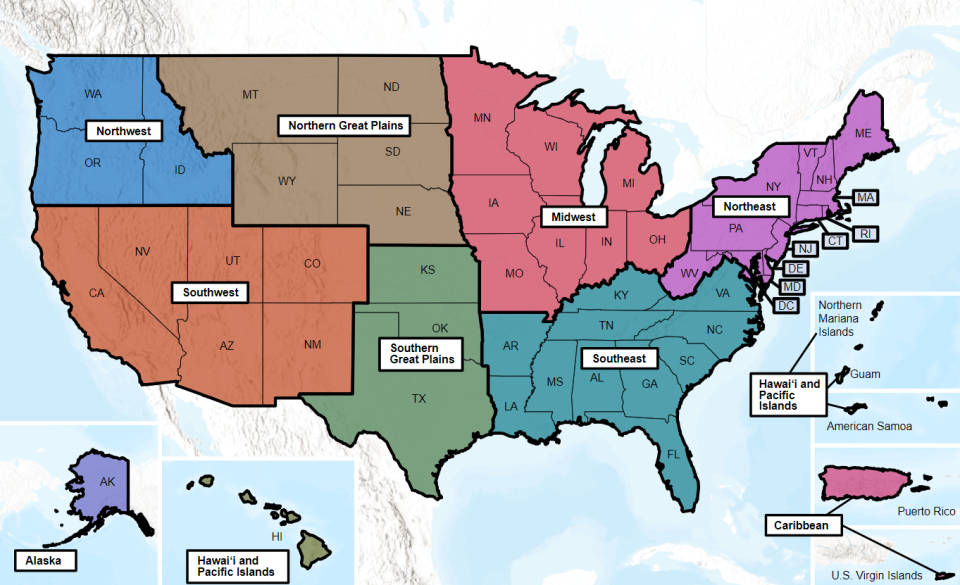Climate Change Connections: Colorado (Winter Sports)
Climate change is impacting all regions and sectors of the United States. The State and Regional Climate Change Connections resource highlights climate change connections to culturally, ecologically, or economically important features of each state and territory. The content on this page provides an illustrative example. As climate change will affect each state and territory in diverse ways, this resource only describes a small portion of these risks. For more comprehensive information about regional climate impacts, please visit the Fifth National Climate Assessment and Climate Change Impacts by Sector.
On this page:
Introduction: Winter Sports Provide Important Recreation and Economic Opportunities

Colorado is known for its beautiful nature and abundant outdoor recreation offerings. Every winter, millions of people head to the state’s slopes and trails to enjoy an array of winter sports, including skiing, snowboarding, snowshoeing, and snowmobiling. Skiers have many options to choose from, as the state boasts nearly 30 ski areas.1
Colorado has the largest winter sports industry in the United States, and this industry substantially contributes to the state's economic activity. In 2021 alone, snow-related activities generated about $1.3 billion in economic value in the state.2 Businesses beyond the slopes also benefit as visitors frequent hotels, grocery stores, restaurants, and other local establishments.
Climate Impacts: Warming Temperatures Are Affecting Colorado’s Snow Sports
Increased greenhouse gas concentrations in the atmosphere are causing temperatures to rise globally.3 In the United States, average winter temperatures have risen particularly quickly compared with other seasons.4 Winter temperatures in Colorado have risen about 3.2°F since 1896, compared with increases between 2°F and 2.7°F for the other seasons.4 Warmer winters can lead to reductions in snowpack, shorter snowfall seasons, earlier snow melting, and more precipitation falling as rain instead of snow, which can have a variety of consequences for water management, ecosystems, and winter recreation.5
Snowpack across the western United States has declined in recent years, and scientists expect these losses to continue with climate change.6,7 In a warming climate, more precipitation will be expected to fall as rain rather than snow in most areas. The number of days below freezing has decreased in recent years, which reduces the likelihood of conditions needed for snow to fall.8 Conditions too warm for snow to accumulate, more winter rain than snow, and a general lack of winter precipitation can all contribute to reduced extent and depth of snowpack.9,10
Snowfall intensity and timing could also vary more as winter precipitation patterns change. While precipitation changes are more difficult to model than temperature, some studies have projected an increase in heavy precipitation events relative to light and moderate events in the Rocky Mountains.11 This could mean more sporadic snowstorms with fewer mild events throughout the winter, leading to a less reliable snow season. Less snow can negatively affect winter sports tourism and the regional economies it supports. For example, cross-country skiing, snowshoeing, and snowmobiling can be affected if trails become muddy or slushy earlier in the year or do not receive snow at all.
Earlier snowmelts can force ski facilities to shorten their seasons, reducing the time that outdoor enthusiasts can enjoy winter recreation. Many winter recreation locations in Colorado are expected to have a shorter ski season by mid-century, with even greater decreases by 2090.12 Shorter seasons can result in steep economic losses for local businesses as visitation declines due to the lack of snow. Even areas that usually get consistent snow can be affected. For example, the high-elevation Arapahoe Basin Ski Area, which has the longest season of all the resorts in the state, was forced to end its ski season a month early during the particularly low-snowfall winter of 2011–2012.13,14
Taking Action: Adapting to Warming Winters

Addressing climate change requires reducing greenhouse gas emissions while preparing for and protecting against current and future climate impacts. Communities, public officials, and individuals in every part of the United States can continue to explore and implement climate adaptation and mitigation measures. Continued changes in the snow season length, as well as the amount, timing, and reliability of snow will likely have profound effects on snow sports. In Colorado, the snow sports industry is already embracing many adaptation measures in the face of changing winters, including:
- Diversifying offerings. With shorter seasons and less snow, there are opportunities for different types of recreation.15 Some resorts have tried to adapt by increasing their offerings of non-snow-based and off-season activities, such as mountain biking, alpine slides, climbing walls, and other recreational activities.13 This diversification helps ensure revenue each year, even if a low-snow year reduces winter visitation.
- Changing schedules. With warming temperatures shortening the snow season, winter sports enthusiasts may need to adjust the timing of their adventures due to inconsistent snow conditions. Some people may adapt by changing the timing and frequency of their trips. Others might decide not to ski or snowboard at all due to changing snow conditions. People who enjoy winter sports that may not benefit from snowmaking, such as snowshoeing, could miss out on a season due to lack of snow.
- Creating artificial snow. Ski operations have supplemented snow to keep mountains in operation during low-snow winters by creating artificial snow. However, snowmaking still requires temperatures below freezing and does not work if temperatures are too high.8 While it may be an adaptive strategy, snowmaking can be an expensive, energy- and water-intensive process.16 Running snowmakers that use fossil fuels emits greenhouse gases, and pumping groundwater to make snow removes water from a source that is slow to recover. Ski facilities can work to offset these resource-intensive requirements by powering snowmakers with renewable microgrid energy and ensuring sustainable water sourcing.
To learn more about climate change impacts in Colorado and the Southwest region, see Chapter 28 of the Fifth National Climate Assessment.
Related Resources
- EPA Climate Change Indicators: Snowfall
- EPA Climate Change Indicators: Snowpack
- Colorado State Climate Summary 2022 (NOAA)
- Climate Change in Colorado (Colorado Water Conservation Board)
References
1 Ski resorts Colorado. (n.d.). Colorado Tourism Office. Retrieved October 17, 2024, from https://www.colorado.com/colorado-ski-resorts
2 U.S. Bureau of Economic Analysis. (2022). Outdoor recreation satellite account, U.S. and states, 2021. https://www.bea.gov/news/2022/outdoor-recreation-satellite-account-us-and-states-2021
3 EPA. (2023). Climate change indicators: Greenhouse gases [Reports and Assessments]. Retrieved November 7, 2023, from https://www.epa.gov/climate-indicators/greenhouse-gases
4 EPA. (2022). Climate change indicators: Seasonal temperature. Climate Change Indicators. Retrieved June 11, 2024, from https://www.epa.gov/climate-indicators/climate-change-indicators-seasonal-temperature
5 White, D. D., Elias, E. H., Thomas, K. A., Bradatan, C. E., Brunson, M. W., Chischilly, A. M., Enquist, C. A. F., Fisher, L. R., Froehlich, H. E., Koebele, E. A., Méndez, M., Ostoja, S. M., Steele, C., & Vanos, J. K. (2023). Ch. 28. Southwest. In A. R. Crimmins, C. W. Avery, D. R. Easterling, K. E. Kunkel, B. C. Stewart, & T. K. Maycock (Eds.), Fifth National Climate Assessment. U.S. Global Change Research Program. https://doi.org/10.7930/NCA5.2023.CH28
6 EPA. (2022). Climate change indicators: Snowpack. Retrieved December 16, 2023, from https://www.epa.gov/climate-indicators/climate-change-indicators-snowpack
7 Mote, P. W., Li, S., Lettenmaier, D. P., Xiao, M., & Engel, R. (2018). Dramatic declines in snowpack in the western US. Npj Climate and Atmospheric Science, 1(2). https://doi.org/10.1038/s41612-018-0012-1
8 EPA. (n.d.). Climate change indicators: Freeze-thaw conditions [Reports and Assessments]. Retrieved April 26, 2023, from https://www.epa.gov/climate-indicators/climate-change-indicators-freeze-thaw-conditions
9 EPA. (2023). Climate change indicators: Snowfall. Retrieved February 20, 2024, from https://www.epa.gov/climate-indicators/climate-change-indicators-snowfall
10 Harpold, A. A., Dettinger, M., & Rajagopal, S. (2017, February 28). Defining snow drought and why it matters. Eos, 98. http://eos.org/opinions/defining-snow-drought-and-why-it-matters
11 Lute, A. C., Abatzoglou, J. T., & Hegewisch, K. C. (2015). Projected changes in snowfall extremes and interannual variability of snowfall in the western United States. Water Resources Research, 51(2), 960–972. https://doi.org/10.1002/2014WR016267
12 Wobus, C., Small, E. E., Hosterman, H., Mills, D., Stein, J., Rissing, M., Jones, R., Duckworth, M., Hall, R., Kolian, M., Creason, J., & Martinich, J. (2017). Projected climate change impacts on skiing and snowmobiling: A case study of the United States. Global Environmental Change, 45, 1–14. https://doi.org/10.1016/j.gloenvcha.2017.04.006
13 Hagenstad, M., Burkowski, E., & Hill, R. (2018). Economic contributions of winter sports in a changing climate. Protect Our Winters.
14 National Centers for Environmental Information. (2013). Annual 2012 National Snow and Ice Report. Retrieved August 7, 2024, from https://www.ncei.noaa.gov/access/monitoring/monthly-report/snow/201213
15 Scott, D., & McBoyle, G. (2007). Climate change adaptation in the ski industry. Mitigation and Adaptation Strategies for Global Change, 12(8), 1411–1431. https://doi.org/10.1007/s11027-006-9071-4
16 Scott, D., Steiger, R., Rutty, M., Knowles, N., & Rushton, B. (2021). Future climate change risk in the US Midwestern ski industry. Tourism Management Perspectives, 40, 100875. https://doi.org/10.1016/j.tmp.2021.100875

